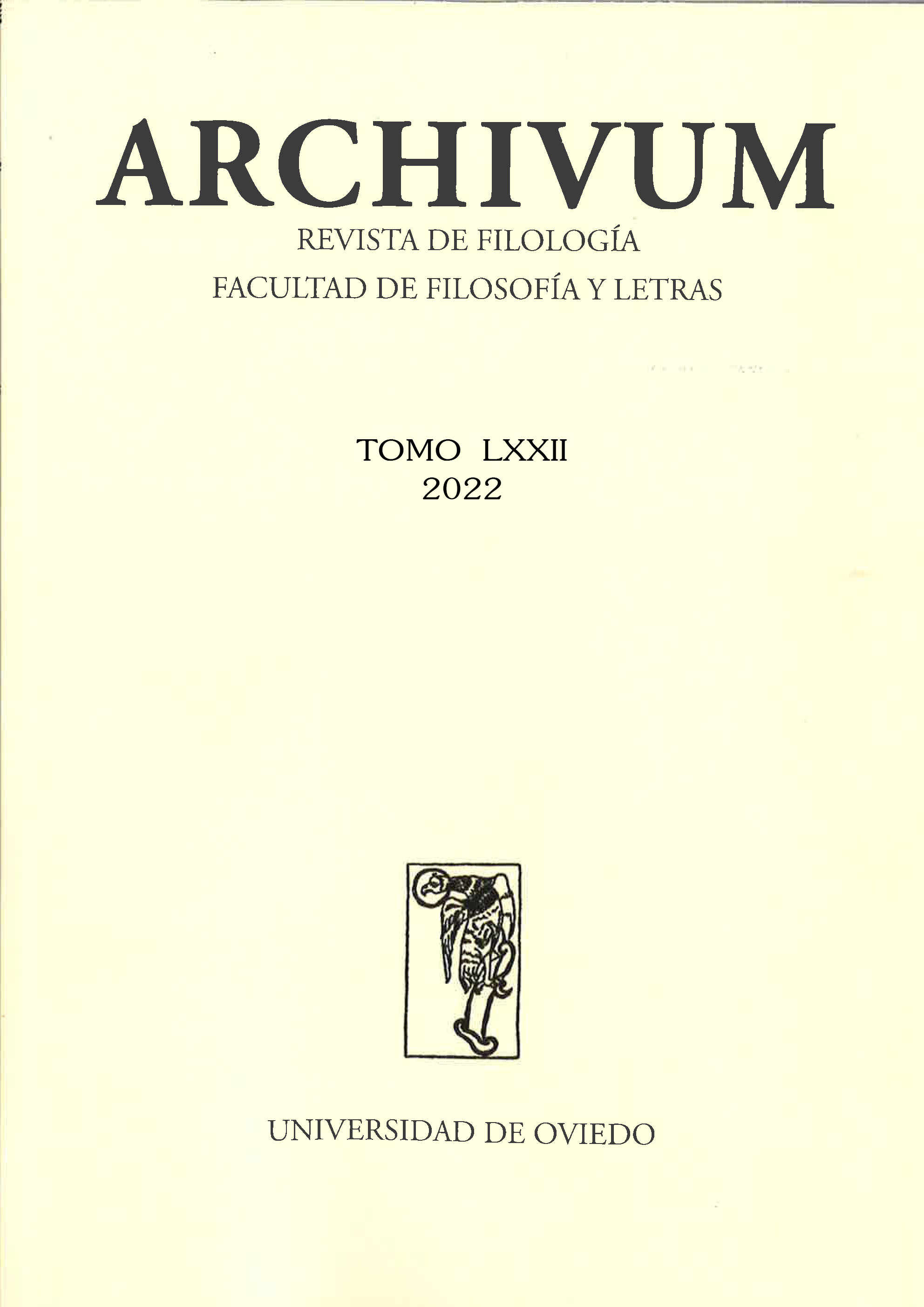Résumé
En este trabajo se estudia la definición y evolución de la música verbal para mostrar cómo —a partir de su significado emocional— crea espacios narrativos únicos, en los que intervienen autor y lector como entes principales. Para ello se parte de la definición de música verbal de Paul Scher, analizada recientemente por Ivan Delazari como música diegética. Acto seguido, se estudia su núcleo semántico (las emociones), el proceso comunicativo que desarrolla y su lenguaje poético. Tras apuntar las características principales de este espacio único creado, se desarrolla un análisis de la música diegética y los espacios que crea en la novela de fantasía épica El nombre del viento, de Patrick Rothfuss.
Références
Albaladejo, T. (2013) “Retórica cultural, lenguaje retórico y lenguaje literario”. Tonos Digital, 25: n. pág. Disponible en: <http://www.tonosdigital.es/ojs/index.php/tonos/article/view/974/> [25/08/2021].
Alimo, D. (2013) “The Name of the Wind – The Lay of Sir Savien Traliard (Fan Made)” [video en línea]. Disponible en: <https://www.youtube.com/watch?v=Dk5ZNHEWDcM> [10/09/2021].
Booth, W. C. (1983 [1961]) The Rhetoric of Fiction. Second Edition. Chicago: The University of Chicago Press.
Castro Balbuena, A. (2016). “De hobbits, tronos de hierro y vikingos. Desarrollo narrativo y cronológico de la fantasía épica”. Tonos Digital, 31, pp. 1-24. Disponible en: <http://www.tonosdigital.es/ojs/index.php/tonos/article/viewArticle/1509> [08/09/2021].
Castro Balbuena, A. (2020) Personajes, espacio y construcción del mundo en la fantasía épica. Un caso español: La saga de Tramórea, de Javier Negrete. Tesis doctoral. Universidad de Almería. Disponible en: <http://repositorio.ual.es/handle/10835/10875> [08/09/2021].
Clifton, J. (2014) Is Storytelling Dead?: Finding Walter Benjamin's Story in the Modern Fantasy Genre. Trabajo de fin de máster. Salem State University. Disponible en: <https://bit.ly/3tok1DL> [08/09/2021].
Connolly, J. (2002 [2010]) El camino blanco. Barcelona: Tusquets Editores.
Delazari, I. (2018) “Overhearing Diegetic Music in Narrative Fiction: Instances of Verbally Transmitted Musical Experience”. Narrative, 26 (2), pp. 221-239.
Freed, J. L. (2020) “What Can't We Believe?: The Persuasive Power of Disnarration in Contemporary Fiction”. Narrative, 28 (2), pp. 200-214.
Genette, G. (1970) “Lenguaje poético, poética del lenguaje”. En Sazbón, J. (comp.) Estructuralismo y literatura. Buenos Aires: Ediciones Nueva Visión, pp. 53-80.
Giebert, S. (2013) “Boxes within boxes and a useless map. Spatial (and temporal) phenomena in the Kingkiller Chronicles”. Komparatistik Online, 2013, pp. 106-114. Disponible en: <https://www.komparatistik-online.de/index.php/komparatistik_online/article/view/103> [09/09/2021].
King, S. (2009 [2011]) La cúpula. Barcelona: Random House Mondadori.
López Eire, A. (1999) “La Retórica y la fuerza del lenguaje”. En Paraíso, I. (ed.). Téchne Rhetoriké. Reflexiones actuales sobre la tradición retórica. Valladolid: Universidad de Valladolid, pp. 19-53.
Mitchell, W. J. T. (1980) “Spatial Form in Literature: Toward a General Theory”. Critical Inquiry, 6 (3), pp. 539-567. Disponible en: <https://www.jstor.org/stable/1343108?seq=1> [17/08/2021].
Moorcock, M. (1987) Wizardry and Wild Romance. Londres: Victor Gollancz.
Neumeyer, D. (2000) “Performances in early Hollywood sound films: Source music, background music, and the integrated sound track”. Contemporary Music Review, 19 (1), pp. 37-62.
Orlov, H. (1981) “Toward a Semiotics of Music”. En Steiner, W. (ed.). The Sign in Music and Literature. Austin: University of Texas Press, pp. 131-137.
Ortega y Gasset, J. (2005) Obras completas. Tomo III. (1917-1925). Barcelona: Taurus.
Powell, D. A. (2001) While the Music Lasts. The Representation of Music in the Works of George Sand. Lewisburg: Bucknell University Press.
Rabinowitz, P. J. (2004) “Music, Genre, and Narrative Theory”. En Ryan, M.-L. (ed.). Narrative across Media. The Languages of Storytelling. Lincoln-Londres: University of Nebraska Press, pp. 305-328.
Radigales, J. (2008) La música en el cine. Barcelona: Editorial UOC.
Rodríguez, F. G. (2016). “Música y significado: Acerca del continuum comunicativo de Ian Cross y de la semioticidad de la experiencia musical”. Signa, 25, pp. 903-924. Disponible en: <http://revistas.uned.es/index.php/signa/article/view/16918> [10/09/2021].
Rodríguez Pequeño, F. J. (1991) “Referencia fantástica y literatura de transgresión”. Tropelías, 2, pp. 145-156. Disponible en: <https://papiro.unizar.es/ojs/index.php/tropelias/article/view/3461> [08/09/2021].
Rothfuss, P. (2007) The Name of the Wind. Londres: Gollancz.
Rothfuss, P. (2014) “Patrick Rothfuss: ‘A Writer of Things’” [vídeo en línea]. Disponible en: <https://www.youtube.com/watch?v=hLmI-gsRWLw&> [27/08/2021].
Scher, S. P. (1970) “Notes toward a Theory of Verbal Music”. Comparative Literature, 22 (2), pp. 147-156.
Scruton, R. (2009) Understanding Music: Philosophy and Interpretation. Londres-Nueva York: Continuum Books.
Smith, J. (2009) “Bridging the Gap: Reconsidering the Border between Diegetic and Nondiegetic Music”. Music and the Moving Image, 2 (1), pp. 1-25.
Stableford, B. (2005) Historical Dictionary of Fantasy Literature. Oxford: The Scarecrow Press.
Tikkanen, T. (2018) Hero, Shadow and Trickster. Three Archetypes in Kingkiller Chronicles. Trabajo de fin de máster. Universidad de Oulu. Disponible en: <http://jultika.oulu.fi/Record/nbnfioulu-201811153046> [09/09/2021].
Tomková, J. (2016) Implications of Names in The Name of the Wind by Patrick Rothfuss. Trabajo de fin de grado. Universidad Masaryk (Brno). Disponible en: <https://is.muni.cz/th/396786/pedf_m/> [08/09/2021].
Tolkien, J. R. R. (2001 [1954]) The Lord of the Rings. Part One: The Fellowship of the Ring. Londres: HarperCollins.
Valles Calatrava, J. R. (1999) El espacio en la novela. El papel del espacio narrativo en La ciudad de los prodigios, de Eduardo Mendoza. Almería: Universidad de Almería.
Valles Calatrava, J. R. (2002) Diccionario de teoría de la narrativa. Granada: Editorial Alhulia.
Villalba, X. (2017) Análisis de las técnicas de traducción utilizadas en catalán y castellano para los términos propios del universo que inventa Patrick Rothfuss en The Name of the Wind. Trabajo de fin de grado. Universidad Autónoma de Barcelona. Disponible en: <https://ddd.uab.cat/record/189541> [08/09/2021].
Villanueva, D. (1992 [1989]) El comentario de textos narrativos: la novela. Gijón: Ediciones Júcar.
Williamson, J. (2005) “Introduction”. En Williamson, J. (ed.). Words and Music. Liverpool Music Symposium 3. Liverpool: Liverpool University Press, pp. 1-9.
Wolf, W. (1999) The Musicalization of Fiction. A Study in the Theory and History of Intermediality. Ámsterdam-Atlanta: Editions Rodopi.
Zoran, G. (1984) “Towards a Theory of Space in Narrative”. Poetics Today, 5 (2), pp. 309-335. Disponible en: <https://www.jstor.org/stable/1771935?seq=1> [17/08/2021].
Zunshine, L. (2006). Why We Read Fiction. Theory of Mind and the Novel. Columbus: The Ohio State University Press.

Ce travail est disponible sous licence Creative Commons Attribution - Pas d'Utilisation Commerciale - Pas de Modification 4.0 International.

